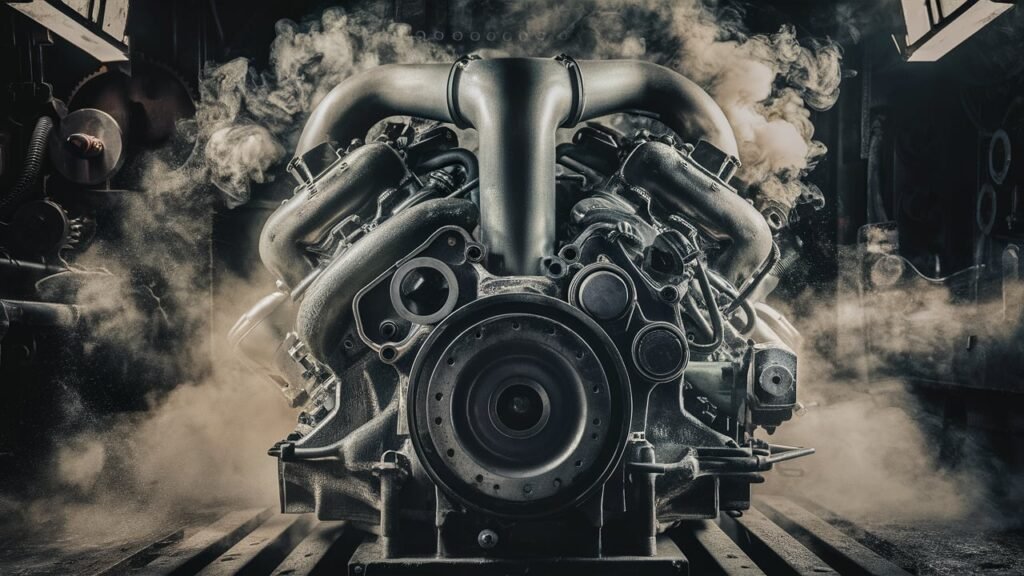
Signs Your Car Engine Fan Clutch Needs Attention
Here are 10 signs that your car engine fan clutch needs attention:
Excessive Noise: Unusual noises from the cooling fan system while driving, which could indicate a problem with the fan clutch.
Engine Overheating: The engine overheating, which is often the first symptom of a failing fan clutch. This can be due to the fan clutch not disengaging properly, preventing the cooling fan from operating efficiently.
Reduction in Performance: A reduction in engine performance, which can be caused by a faulty fan clutch that prevents the cooling fan from operating effectively, leading to reduced engine power.
Continuous Fan Operation: The cooling fan continuously spinning, even when the engine is not hot, which can be a sign of a faulty fan clutch.
Difficulty Spinning Fan Blades: Difficulty spinning the fan blades when the engine is cold, indicating excessive play or wear in the fan clutch.
Unusual Fan Behavior: The fan not stopping when the engine is turned off, which can be a sign of a faulty fan clutch.
Slippage: A worn clutch will begin to slip, causing the gear to disengage under heavy loads. This is a sign that the clutch needs attention.
Burning Smell: A burning smell similar to burnt toast, which can be a sign of a damaged clutch plate due to prolonged use in slow-moving traffic.
Smoke: Smoke coming from beneath the car, which can be a sign of a damaged clutch plate.
Poor Fuel Economy: Poor fuel economy, which can be caused by a faulty fan clutch that prevents the engine from running efficiently.
These signs can help you identify potential issues with your car engine fan clutch and ensure timely maintenance to avoid more severe problems.
Within the intricate mechanics of a car engine lies a crucial component often overlooked yet vital for optimal performance – the fan clutch. This mechanism, designed to regulate the cooling fan’s speed in response to temperature changes, plays a pivotal role in maintaining the engine’s operational efficiency.
As an automotive enthusiast or meticulous car owner, understanding what a car engine fan clutch entails and how it contributes to the vehicle’s functionality is paramount.
The fan clutch functions as a control device that connects and disconnects the engine-driven radiator fan when needed, aligning its speed with the engine’s temperature requirements. Efficient cooling is essential for preventing overheating, ensuring engine longevity, and sustaining optimal performance levels.
By comprehending the workings of this system, you are equipped with insights into how intricately engineered components synchronize harmoniously to safeguard your vehicle’s well-being on the road. Join us as we delve into 8 telltale signs that could indicate your car engine fan clutch requires immediate attention, helping you maintain peak operating conditions and peace of mind while driving.
Signs Your Car Engine Fan Clutch Needs Attention.
When your car’s engine fan clutch starts to falter, several telltale signs emerge, indicating a need for prompt attention. One prominent indicator is overheating problems. A malfunctioning fan clutch fails to engage properly, leading to insufficient air circulation through the radiator.
As a result, your engine may start to overheat, potentially causing severe damage if left unaddressed. Monitoring your temperature gauge and coolant levels can alert you to early signs of cooling system trouble related to a failing fan clutch.
Another red flag signaling fan clutch issues manifests as unusual noises emanating from under the hood. If you hear roaring sounds or excessive buzzing while driving, particularly when the engine is hot, it could signify that the fan clutch is not functioning optimally. Investigating these auditory clues promptly can help diagnose and rectify any impending problems before they escalate.

Furthermore, a declining engine performance could point towards a deteriorating fan clutch mechanism. When the fan does not engage correctly due to a faulty clutch, the engine may experience reduced power output and an uptick in fuel consumption.
These adverse effects on performance highlight the interconnectedness of the various components in your vehicle’s cooling system and emphasize the critical role of a well-functioning fan clutch in maintaining optimal engine efficiency. Addressing these performance issues promptly can prevent further complications down the road.
Inconsistent cooling patterns.
Inconsistent cooling patterns in your vehicle may be a subtle yet crucial indicator that your car engine fan clutch requires attention. Hot spells, where the temperature gauge fluctuates unexpectedly, can often be traced back to a malfunctioning fan clutch failing to engage properly.
For example, if your engine’s temperature rises rapidly during normal driving conditions or when idling, it could signify issues with the fan clutch mechanism not activating when needed. This inconsistency in cooling can lead to overheating and potential damage to engine components if left unaddressed.
Conversely, cold spikes – instances where the engine temperature drops below optimal levels – can also point towards a faulty fan clutch regulating airflow incorrectly. If you notice that your vehicle takes longer than usual to warm up or struggles to reach operating temperatures, despite being driven under normal circumstances, the fan clutch might not be functioning as intended.
These fluctuations in temperature can impact engine efficiency and performance, emphasizing the importance of addressing fan clutch issues promptly for overall vehicle health.
Moreover, stop-and-go traffic situations can exacerbate problems with an inefficient fan clutch. In these conditions where consistent cooling is essential due to frequent stops and starts causing rapid changes in engine load and temperature, a malfunctioning fan clutch may struggle to maintain adequate airflow across the radiator.
This inefficacy can result in temperature spikes or erratic gauge readings. By recognizing how stop-and-go traffic scenarios can unveil underlying fan clutch issues, drivers can proactively address cooling system concerns before they escalate into major mechanical failures. Regular monitoring of these symptoms is key to ensuring optimal performance and longevity of your car’s engine cooling system.
Physical Inspection Techniques.
Conducting physical inspections to assess the condition of your car’s engine fan clutch can help you catch potential issues before they escalate. By following these techniques, you can proactively maintain your vehicle’s cooling system and prevent costly repairs down the road.
Firstly, perform a fan movement assessment by gently attempting to rotate the fan blades when the engine is turned off. The blades should spin freely without any resistance or wobbling, indicating that the fan clutch is functioning properly. Any stiffness or grinding sensations during this test may signify a problem with the clutch mechanism, requiring further attention.
Secondly, check for fluid leaks around the fan assembly as this could be a sign of a failing fan clutch. Leaking fluid near the fan indicates a potential seal failure within the clutch unit, compromising its ability to engage effectively. Monitoring and addressing these leaks promptly can prevent overheating issues caused by inadequate airflow due to a malfunctioning fan clutch.

Lastly, visually inspect the fan blades and shroud for signs of wear or damage that could indicate impending problems with the fan clutch. Look for cracks, chips, or excessive dust accumulation on the blades, as well as any irregularities in the shroud that might impact airflow. Identifying these visual cues early on allows you to address potential fan clutch issues before they escalate into more significant cooling system malfunctions.
By incorporating these physical inspection techniques into your routine maintenance schedule, you can ensure that your car’s engine fan clutch remains in optimal working condition. Additionally, regular checks can help you preemptively detect any emerging issues with the clutch mechanism and address them promptly to maintain efficient engine cooling performance.
Maintenance and Repair Procedures.
Ensuring the smooth operation of your car’s engine fan clutch involves more than just identification of issues – proactive maintenance plays a key role in preserving its functionality. When considering the health of your cooling system, conducting thorough timing belt inspections stands out as an essential task.
A loose or misaligned timing belt can not only affect engine performance but also indirectly impact the efficiency of the fan clutch. By regularly checking for correct tension and alignment in the timing belts, you can prevent potential issues that might compromise the cooling system’s overall effectiveness.
In addition to monitoring timing belts, evaluating the thermostat’s operation emerges as another crucial step in maintaining a healthy cooling system environment. A faulty thermostat can lead to imbalanced temperature regulation within the engine, consequently placing unnecessary strain on the fan clutch mechanism.
This strain not only reduces the lifespan of the fan clutch but also hampers its ability to regulate airflow efficiently. Therefore, by periodically assessing and replacing thermostats when needed, you can ensure that your car’s cooling components work harmoniously together.
Despite diligent preventive measures, there may be instances where DIY checks fail to rectify underlying problems with your car engine’s fan clutch. In such cases or when facing complex issues beyond basic inspections, seeking professional consultation is highly recommended.
Skilled mechanics possess specialized knowledge and tools that can identify nuanced concerns within the cooling system and address them effectively. Their expertise ensures a comprehensive assessment of fan clutch-related issues, leading to precise repairs or replacements when necessary, ultimately optimizing your vehicle’s cooling performance efficiently.
Conclusion.
In the realm of automotive maintenance, a well-functioning car engine fan clutch is crucial for optimal cooling system performance. Recognizing the signs that indicate your fan clutch needs attention can help preempt serious engine issues down the road.
From overheating problems to unusual noises and inconsistent cooling behaviors, staying vigilant about these warning signals is key to addressing potential fan clutch malfunctions promptly.
By paying heed to symptoms like erratic temperature fluctuations and diminished engine performance, conscientious car owners and mechanics alike can troubleshoot fan clutch issues effectively before they escalate into more severe complications.
Engaging in regular physical inspections, including assessing fan movement, detecting fluid leaks, and scrutinizing visible wear on components, can aid in early diagnosis and targeted maintenance interventions.
Remember, ensuring proper functioning of your car engine’s fan clutch not only safeguards against overheating but also optimizes overall engine efficiency and longevity. Stay proactive in monitoring these telltale signs and take timely action to keep your vehicle running smoothly for miles to come.




